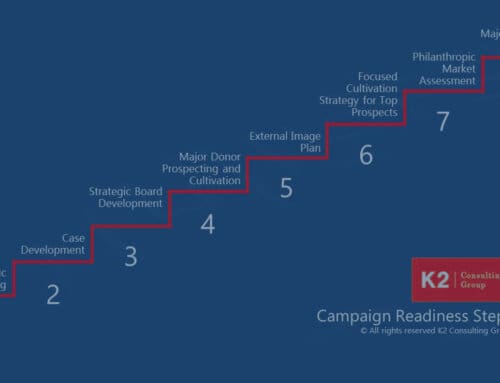Experiencing a lot of development officer turnover? Hire Development Professionals who stay. Learn what I look for when hiring development professionals (PART III of III in our series on development officer turnover)
In my early 30’s I was recruited to become V.P. of Advancement for a large, multi-site $85 million association. I took on a much-expanded portfolio, in an unfamiliar city, serving an organization in major transition. An immense challenge!
The organization’s vision required an ambitious plan for development. But the development operation was, let’s just say, unsophisticated and under performing. We would not be successful without the right people in place. It wasn’t easy recruiting the right team of professionals, because:
- The organization was not recognized for successful fundraising.
- I was locally unproven — a newcomer in a big city where top development professionals were chummy and close-knit. Our CEO was also a transplant.
- The expectations of the development positions were daunting.
- There wasn’t a budget for executive search.
This predated the era of reality TV, but the churn of candidates I interviewed would have made for an interesting series. I often imagined a cartoon revolving door: around went the applicant parade, many of them saying as they stepped out that our plans were admirable but not for them.
I wouldn’t be sharing tips on hiring if all this didn’t end well! We hired an outstanding team that successfully educated the organization on fundraising best practices, improved its annual fundraising, and executed a major capital campaign. And I earned some hiring insights that were lauded as one of my top skills by my next CEO. Here they are:
Position yourself within the circles where you seek candidates
Advertising open positions is not enough — you must also become known as someone who is successful and good to work for. That reputation pays off in referrals and when candidates are doing their due diligence. For me as a transplant, this meant building relationships locally, so I joined the local AFP board and chaired two major conferences. Meet your peers through associations and organizations. Leverage your board members’ networks. By positioning yourself, you also position the organization. Today, organizations find high performers with the right attitudes from the “Underground Job Market” which are sourced through referrals and networking, rather than the traditional job posting sources.
Understand the position for which you are hiring
You don’t need to have performed the advancement function for which you are recruiting, but you should understand what it takes to be successful in the role. When supervisors don’t understand the job they’re recruiting for, that’s a recipe for turnover. Whether you are a CEO or CDO, network with knowledgeable peers to understand the targeted role, what skills the supervisor will need, and what will constitute a healthy relationship between leader and new hire.
Know yourself and your leadership style
Self-awareness cannot be underestimated as a top leadership quality. Understand your style and communicate it to potential hires; that’s healthy and will enhance your chances of a strong partnership. Bite the bullet and build leadership skills you secretly know you could improve, whether through coaching, classes or other self- improvement opportunities. The best CEO/CDO relationships are open, honest and supportive partnerships; if you’re inclined to micromanage or avoid engagement in fundraising, you are flirting with unpleasant turnover surprises.
Define the characteristics you’re looking for
I have a penchant for startups and for organizations in transition or with big goals; consequently, I look for entrepreneurial individuals who welcome challenges as opportunities to make something big happen. They may not have all the skills necessary, but their smarts and ambition quickly erase any deficit. I look for people who strive for the highest quality work product. Because the only constant is change, I prize flexibility, adaptability, confidence and comfort with ambiguity. I love people with a sense of humor who laugh at themselves, provide levity, and make work fun. Because I recruit for openness and honesty, I trust my hires and their trust is reciprocated.
Prepare an operating plan for the position
Don’t stop with a job description; create an action or operating plan specific to the position. Job descriptions are laundry lists of responsibilities; an operating plan lays out the organization’s objectives and the incumbent’s expected contribution. An operating or action plan includes:
- Clear objectives
- Activities and deliverables to achieve these objectives
- Quality standards for work produced
- Desired outcomes
- Staffing and resource requirements
- Implementation timetables
- A process for monitoring and evaluating progress
Action plans are effective because they clarify the deliverables, the resources needed, the necessary skills and measures of progress. Everyone agrees to the goals up front.
When I am very close to a hire, I let the candidate review the action plan. Their reaction – questions, suggestions, enthusiasm – helps us both discern if this is a fit.
Schedule a 90-day check-in
Everyone wants to know how they are doing when assuming a new position. After 90 days, review progress against the operating plan. Clearly, top priorities change and are negotiable, but the 90-day review starts your new hires at a sprint and demonstrates your support and guidance.
K2 Consulting Group does not conduct searches, but we’re happy to consult with CEOs and directors of development who want to design operating plans for development, evaluate internal capacity, or gain insight into the skills, competencies, and characteristics needed for a successful development operation.
Ready to get started on reaching your potential? Contact us to get started.







